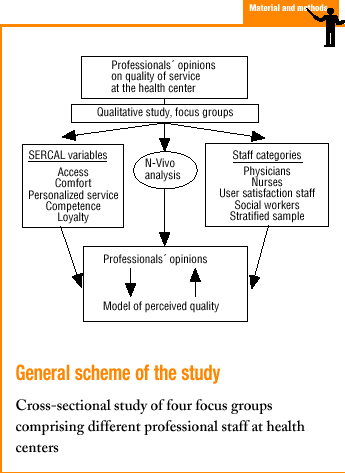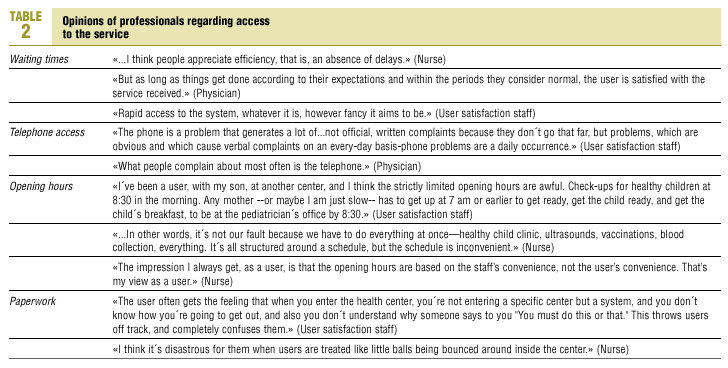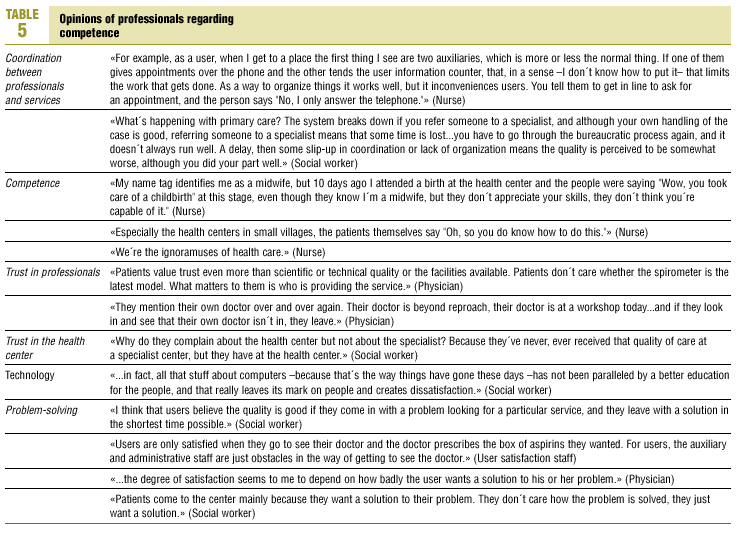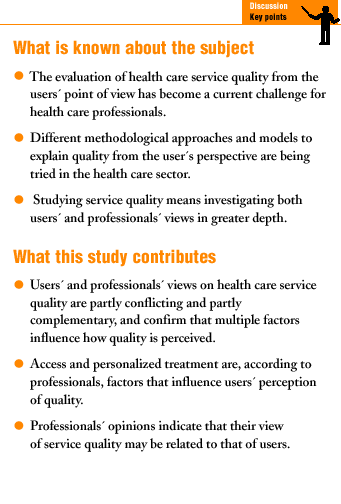N-Vivo. Resultados. Todas las dimensiones del modelo teórico han sido identificadas por los profesionales como constructoras de la percepción que el usuario tiene de la calidad del servicio. Las visiones de usuarios y profesionales se contraponen y se complementan, generando un modelo susceptible de validación. El acceso, el trato y la solución del problema son variables clave. Conclusiones. La opinión de los profesionales proporciona información para mejorar el modelo de calidad predefinido. Es necesario estudiar las diferencias en la opinión entre usuarios y profesionales según los valores e intereses de estos colectivos y el contexto de la atención. Los profesionales identifican la accesibilidad, el trato y la solución del problema como características que influyen en la opinión que tiene el usuario sobre la calidad del CS.
Introduction
Evaluating service quality and identifying critical factors that determine user satisfaction are challenges for client-oriented policies in primary health care services.1,2 The problems inherent in identifying the attributes of quality and evaluating services from the user´s perspective have become issues that now attract the interest of professionals, managers, politicians and researchers.3 In the health sector, different methodological approaches and models that explain service quality from the user´s perspective are currently being tested.4-6
Several authors7,8 have discovered that for users, service quality does not consist simply of actions and behaviors in themselves, but also comprises the subjective manner in which these are perceived and interpreted. The complexity of measuring service quality becomes evident if we realize that it is intangible and heterogeneous, and that it is impossible to separate
the moment of production from the moment of consumption.7-9
In recent years a number of instruments have been used to try to measure patient satisfaction as a fundamental factor in health care outcomes.10,11 This task is not without problems. For example, it is hard to distinguish between the care process (service) and its outcomes.12
Traditionally, studies designed to measure perceived service quality have been based on an analysis of the degree of user satisfaction, and have evolved from simple questionnaires to factorial studies with considerable statistical backing.12-14 Qualitative methods seek to obtain in-depth information about the phenomenon, and to produce an in-depth interpretation of opinions on quality.
One of the instruments used during the previous ten years to measure quality is the SERVQUAL model,15 which is based on a definition of quality as the difference between users´ expectations and their perceptions. An adaptation of this model to the health care setting is the SERCAL model,4,6 developed from research aimed at evaluating users´ opinions on health service quality and constructed from a combination of qualitative and quantitative methods. The quality factors that the SERCAL model evaluates are access, comfort, personalized service, competence (guarantees to patients) and loyalty to the health center.
Although the patients´ view is of fundamental importance in understanding their opinion about service, improving the quality of care does not seem possible without involving practitioners. Some authors8,16 consider client satisfaction to be based on the satisfaction of professionals and their concept of service quality as providers of the service. An organization must consider not only the degree to which users´ interests are satisfied; if improvement is desired, it should also serve the interests of professionals.17 From this perspective, quality can be defined in terms of professionals´ decisions and behaviors that are expected to yield the greatest benefits for patients.
It is therefore of interest to determine how professionals perceive the benefits of care, and what actions they consider to contribute to patients´ perceptions of better primary health care service. Relating users´ views on quality and professionals´ perspectives may be a crucial step in designing health care processes and improving their outcomes.
The aim of the present study was to report on professionals´ opinions on service quality at primary health care centers. We also set out to determine how salient the dimensions defined in the SERCAL model were in the resulting information.
Methods
In this cross-sectional study qualitative methods were used to obtain in-depth information on the opinions of practitioners´ working at primary health care centers.
The setting was the Bahía de Cádiz and La Janda health centers in the province of Cádiz (southwestern Spain).
Information was obtained with the focus group technique, based on the so-called grounded theory.18 A meeting was held with different staff members selected on the basis of similarities in their profiles, and participants were selected on the basis of their functions at the centers regarding services provided to users. The aim was to record the opinions of all professionals, and their different perspectives and views on users´ perceptions of quality.
Four focus groups were studied:
Group 1: family physicians and pediatricians at both centers.
Group 2: user satisfaction service staff.
Group 3: social workers.
Group 4: nurses.
During the meeting a script was developed on the basis of the dimensions in the model (Table 1), with sufficient internal flexibility to allow exploration of new aspects and dimensions of the topic while respecting the options and terms used by participants.
Relations were sought between the model and three types of question: what are professionals´ views on how patients perceive quality? What opinions do professionals have on service quality at each center? What factors do professionals consider most important in defining a user-oriented quality service?
The information was analyzed with the N-Vivo program, a qualitative data analysis assistant. N-Vivo19 brings together the features and applications needed to facilitate and systematize text analysis: it can be used initially to identify discourse categories in the data, and subsequently to explore existing combinations of such categories with nodes that facilitate the identification of redundant text elements.
Redundancy and saturation were ensured by repeat analysis of the information by more than one investigator. The information was also checked by selecting intragroup and intergroup redundant elements.
Results
Service accessibility (Table 2)
Access to the service is one of the dimensions the professionals considered most important for quality service, and for which there was notable agreement regarding its influence on the user´s perception.
According to professionals, users value speed in accessing the system, a feature identified as a characteristic of service quality and a positive image of the center.
Participants considered that the perception of waiting times varies depending on a) the location of the health center in a rural or an urban area; b) the reason for visiting the center, and c) the level of care involved in the consultation. They believed that accessibility was related with the user´s understanding of the functions performed by certain members of the staff (user satisfaction staff), and that users consider this an obstacle that interferes with their main interest as a patient: being seen by their doctor. They also noted that telephone access generated complaints and negative views on the part of users, and that the complaints are identified by user satisfaction staff as a source of tension and problems that affect their workplace conditions, and can trigger arguments with users.
With regard to routine paperwork, professionals noted confusion and lack of coordination, reflected in the need for users to visit different centers and offices and in the fact that users «need to do some running around.»
Efficiency and speed of the paperwork was an element that participants said should be improved. They related excess bureaucracy with a lack of coordination between professionals and services. They also felt that inadequate training of professionals in the use of new technologies led to an increase in paperwork and often brought the system to a halt.
Waiting time at the center to make an appointment or while waiting in line for other services, time spent in waiting rooms, and delays in answering the phone led to negative perceptions regarding service quality.
On the other hand, when users encountered initiative, a sense of responsibility, and personal interest in their problem on the part of the professional, perceived quality was greater.
Comfort of the service (Table 3)
This dimension was closely related to accessibility of the center´s facilities. Professionals believed that the appearance of the exterior and interior of the center and accessibility accounted for users´ first impression of the center, and were essential in creating satisfaction and an impression of quality.
The participants felt that the physical conditions and comfort were relevant for users, who reach favorable or unfavorable judgments about the physical surroundings in which health care services are provided. Improvements in the physical surroundings were most clearly appreciated by users.
Comfort of the facilities was considered to affect working conditions and the way users are treated.
Personalized service (Table 4)
The greatest discrepancies between groups of staff members were found with regard to the importance of a pleasant demeanor. This was identified by all groups as a factor that influenced users´ opinions on quality, but we interpret their responses as evidence that the relevance given to this factor differed between categories of professionals. All participants agreed that recent improvements in this area were essential in offering quality service. However, physicians maintained that the main thing for users was obtaining a solution for their problem. According to physicians, technical quality is the most important aspect of service.
Nurses and social workers emphasized that personalized treatment is a central component of quality. Social workers noted the importance users assign to how they are treated by physicians.
«...in fact, what is most appreciated is the medical care.» The physician plays the role of the main agent of quality. Both technical quality and personal treatment are relevant for users, and social workers considered that aspects related with personal treatment of users would improve with strategies for training and adaptation to new technologies.
Social workers identified as clients not only users who come to the center because of a health problem, but also the persons who accompany them and habitual clients whose main reason for coming to the center is «to pass the time.»
Social workers believed the most relevant thing for these patients is to find that the staff create a pleasant, polite atmosphere.
Competence (Table 5)
With regard to coordination between professionals and services, participants noted that this dimension is linked to others. Lack of coordination is partly responsible for long waits and excess paperwork, and has a negative influence on how users are treated. Professional competence was a secondary factor in users´ evaluations of service quality. Users assume that physicians have appropriate scientific and technical skills; in other words, the physicians´ competence is guaranteed. Physicians claimed that the user´s goal is to obtain a solution for his or her problem. On the other hand, nurses and user satisfaction staff consider their competence to be underrated by users and even by other categories of staff members.
The user´s confidence in the professionals was considered another relevant factor of quality. Physicians considered this the factor that most strongly influenced users´ perceptions of quality, in comparison to other factors.
Social workers expressed the opinion that the quality of the center and efforts to provide quality are perceived by users, and that this leads, on one hand, to a feeling of trust and confidence that users do not perceive in other health care settings, and on the other hand, to increased expectations and demands regarding service.
The use of technology was believed to have a negative influence on other factors that influence service quality. On many occasions technology inconveniences users because professionals lack information about how it should be used, or because it does not complement or enhance previously used methods. Social workers drew attention to the inadequate training professionals received in the use of technology, particularly as regards computers for information processing.
Physicians noted that deficiencies in the use of technology pointed to the need for better training of user satisfaction staff, and felt that patients do not question the physicians´ competence.
User satisfaction staff members noted problems of coordination between their service and physicians. They commented on their function as «middlemen» between the patient and the consultation with the physician, and declared that despite their belief that they are the members of the center´s staff who are best informed about user satisfaction matters, their opinions are not taken into account.
Nurses expressed the opinion that professionals employed at other health care services such as hospitals failed to appreciate the technical competence of professionals at health centers. Health center nurses noted that the general view of their professional competence was one of poor training and unclear functions. They noted that this view was the result of the fact that they «handle all sorts of tasks» and are not able to «sell» a clear image of their competence as a group. They felt that there ought to be a way to identify them as nurses and distinguish them from other staff members a way to create a (hitherto poorly defined) professional profile.
Loyalty to the service (Table 6)
Participants noted that they would recommend the services provided by the health center to a relative or friend. However, they indicated that they would do so only if allowed to choose which staff members they would be seen by because of their friendliness, technical skills or ability to listen characteristics that led users to trust them. This illustrates that the professionals´ attitudes and characteristics are factors that determine users´ perceptions of the service they receive.
Discussion
Focal group studies make is possible to obtain extensive, in-depth information. The limitations of this technique are the same as with any qualitative technique: open questions that may be interpreted differently or elicit different degrees of insight into how and why phenomena occur. The interest of this technique, however, is not in the measurement process per se.20
The categories we used generated sufficient informational redundancy and an appropriate level of saturation to consider our results an accurate reflection of the collective opinions of different professional groups in primary health care centers in our setting. The information we obtained for each participant profile is insufficient to generate reliable results for each professional collective as a whole, as we studied only one group in each professional category. This suggests that additional studies involving a larger number of groups per category would generate more complete results.
The N-Vivo program, designed to analyze qualitative results, allowed us to reduce the information and make it more easily accessible by relating and grouping different categories. However, as others have noted,19,21 although these programs help with the more labor-intensive tasks of analysis and have many potential benefits, some caution is advisable as many studies claim that they increase the «power» of representativeness, as though they endowed the results with some quantitative features. This detracts from the main tenets that underlie qualitative methods.21
As shown in different studies, several methods are used to obtain users´ opinions, and each method can yield information that can be compared and contrasted.22,23 Similar studies might determine which factors contribute the most to quality of the services offered by primary health care centers from the point of view of professionals and users; methods able to compare the findings24 might be used to reinforce the results obtained with focus group studies.
We note that according to the professionals consulted in this study (particularly physicians), their technical competence is assumed to be beyond question by users, and is therefore guaranteed. This notion was reflected in the discourse in an implicit manner. Other factors, in contrast, appear explicitly as more important, eg, access to services, courteous treatment, the physical environment, and confidence in the professionals.
Our participants also considered that waiting and problems with user access could be explained by the excess demand for care, which in turn has a negative influence on how users are treated by staff members. One factor not mentioned in the information we obtained is the size of the center and the number of users, factors that have a determining influence on how quality is judged.23 This element undoubtedly influences quality evaluations; however, our study design did not allow us to obtain more complete information on this issue.
Members of the user satisfaction staff felt that many of the problems that affected users and their own work were caused by a lack of adequate means and by the limited decision-making capacity of employees who deal face-to-face with users, regarding matters that directly influence their work. Although these employees see themselves as the ones who are most often expected to take steps to ensure user satisfaction, they are not involved in higher-level decision-making processes. This reveals how the workplace atmosphere and job satisfaction of these professionals affects users´ evaluations of the quality of this service.25-27
Some relationship was apparent between dimensions that constitute users´ views regarding the quality of services provided by the health centers. For example, the dimensions credibility, competence and courtesy were seen by nurses to be related. Social workers noted especially that users perceived differences between levels of care provision and care providers in the their position in the professional hierarchy. This suggests that users see the health center as a closed system disconnected from the other levels of health care. The health center is seen as being closer to the user, the lowest level in the hierarchy, where users are treated as equals. According to these opinions, this hierarchy is also perceived by users to exist among professionals at the health center, with physicians at the top of the pyramid.28
As others have reported, the consequences of a bad experience with a given service are that any of the user´s previously positive perceptions disappear. A bad experience, according to professionals, affects the users' overall perception of the service as a whole.1,3
The information we obtained confirms that the perception of quality is composed of multiple factors. We found that all dimensions of the SERCAL model were identified by professionals, which shows that validated models of quality assessment are useful for obtaining users´ opinions and comparing them with those of professionals.29-31
It is noteworthy that the discourse we analyzed contained no explicit mention of issues such as the use of health care technology and information provided by physicians, elements which nonetheless form part of the theoretical model. Further studies are called for to explain this absence.
We suggest that future studies based on this method should take into account features specific to the health centers as opposed to other services such as hospitals32, the diverse nature of users, and the different expectations of each type of user depending on sociodemographic variables and on whether the center is in a rural or an urban area.21 According to professionals, these elements weigh heavily in the user´s perception of quality.
As a final point, it is interesting to note that according to professionals (particularly physicians), the essential factor for users is that the visit to the health center results in a solution to the problem that led the user to seek medical attention (ie, a problem with physical health, according to professionals). The user´s goal is to obtain a solution as quickly as possible. Therefore user satisfaction was defined exclusively as a solution to the problem. However, other elements such as treatment by staff members, waiting times and comfort also help maintain a good perception of the services offered by the center. Therefore problem-solving should be added as a component of quality. This would ensure that the professional´s commitment to and involvement in seeking a solution to the patient´s problem as quickly as possible will influence the user´s degree of satisfaction. However, our results suggest the need for further research to determine whether what professionals perceive to be the patient´s problem, and the solution they offer, actually match the patient´s own perception of the problem and the solution he or she receives from the health center. As noted by professionals in this study, health centers are organized and run in a way that is too inflexible and does not take into account users´ preferences.
Acknowledgments
We thank the staff of the Bahía de Cádiz and La Janda health centers for their cooperation and participation in this study.
We also acknowledge support throughout the different phases of the research from Juan Manuel Jiménez Martín, project technician at the Andalusia School of Public Health.
Correspondence: Mariano Hernán García. Escuela Andaluza de Salud Púbica. Campus Universitario de la Cartuja. Apdo. de Correos 2.070. 18080 Granada. España. E-mail: mhernan@easp.es
This report is part of research project 210559900, financed by the Spanish Fondo de Investigación Sanitaria.
Manuscript accepted for publication 27 February 2002.























